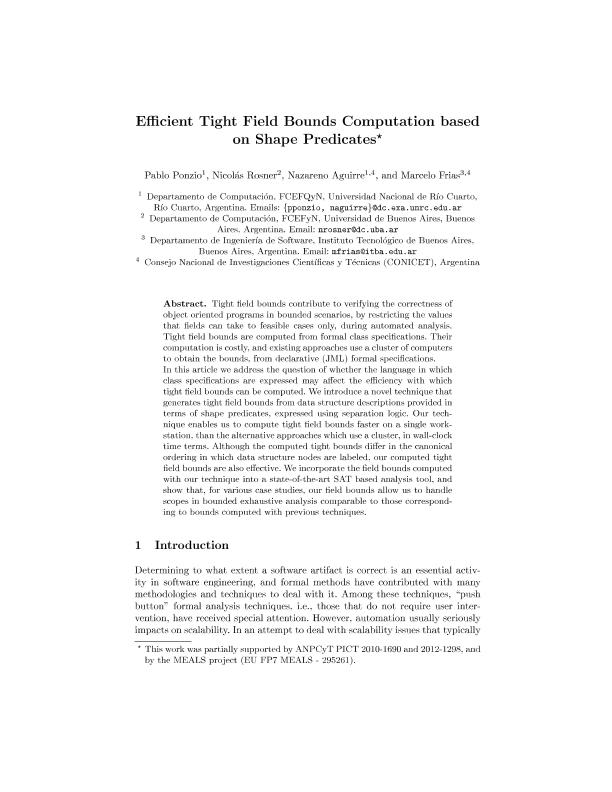Mostrar el registro sencillo del ítem
dc.contributor.author
Ponzio, Pablo Daniel

dc.contributor.author
Rosner, Nicolas Leandro

dc.contributor.author
Aguirre, Nazareno Matias

dc.contributor.author
Frias, Marcelo Fabian

dc.date.available
2018-01-16T19:21:23Z
dc.date.issued
2014-05
dc.identifier.citation
Rosner, Nicolas Leandro; Aguirre, Nazareno Matias; Ponzio, Pablo Daniel; Frias, Marcelo Fabian; Efficient Tight Field Bounds Computation Based on Shape Predicates; Springer; Lecture Notes in Computer Science; FM2014; 5-2014; 531-546
dc.identifier.issn
0302-9743
dc.identifier.uri
http://hdl.handle.net/11336/33484
dc.description.abstract
Tight field bounds contribute to verifying the correctness of object oriented programs in bounded scenarios, by restricting the values that fields can take to feasible cases only, during automated analysis. Tight field bounds are computed from formal class specifications. Their computation is costly, and existing approaches use a cluster of computers to obtain the bounds, from declarative (JML) formal specifications. In this article we address the question of whether the language in which class specifications are expressed may affect the efficiency with which tight field bounds can be computed. We introduce a novel technique that generates tight field bounds from data structure descriptions provided in terms of shape predicates, expressed using separation logic. Our technique enables us to compute tight field bounds faster on a single workstation, than the alternative approaches which use a cluster, in wall-clock time terms. Although the computed tight bounds differ in the canonical ordering in which data structure nodes are labeled, our computed tight field bounds are also effective. We incorporate the field bounds computed with our technique into a state-of-the-art SAT based analysis tool, and show that, for various case studies, our field bounds allow us to handle scopes in bounded exhaustive analysis comparable to those corresponding to bounds computed with previous techniques.
dc.format
application/pdf
dc.language.iso
eng
dc.publisher
Springer

dc.rights
info:eu-repo/semantics/openAccess
dc.rights.uri
https://creativecommons.org/licenses/by-nc-sa/2.5/ar/
dc.subject
Tight Field Bounds
dc.subject
Shape Predicates
dc.subject
Bounded Verification
dc.subject.classification
Ciencias de la Computación

dc.subject.classification
Ciencias de la Computación e Información

dc.subject.classification
CIENCIAS NATURALES Y EXACTAS

dc.title
Efficient Tight Field Bounds Computation Based on Shape Predicates
dc.type
info:eu-repo/semantics/article
dc.type
info:ar-repo/semantics/artículo
dc.type
info:eu-repo/semantics/publishedVersion
dc.date.updated
2018-01-16T18:02:23Z
dc.journal.volume
FM2014
dc.journal.pagination
531-546
dc.journal.pais
Singapur

dc.description.fil
Fil: Ponzio, Pablo Daniel. Consejo Nacional de Investigaciones Científicas y Técnicas; Argentina. Universidad Nacional de Rio Cuarto. Facultad de Cs.exactas Fisicoquímicas y Naturales. Departamento de Computacion; Argentina
dc.description.fil
Fil: Rosner, Nicolas Leandro. Universidad de Buenos Aires. Facultad de Ciencias Exactas y Naturales. Departamento de Computación; Argentina
dc.description.fil
Fil: Aguirre, Nazareno Matias. Consejo Nacional de Investigaciones Científicas y Técnicas; Argentina. Universidad Nacional de Rio Cuarto. Facultad de Cs.exactas Fisicoquímicas y Naturales. Departamento de Computacion; Argentina
dc.description.fil
Fil: Frias, Marcelo Fabian. Consejo Nacional de Investigaciones Científicas y Técnicas; Argentina. Instituto Tecnológico de Buenos Aires; Argentina
dc.journal.title
Lecture Notes in Computer Science

dc.relation.alternativeid
info:eu-repo/semantics/altIdentifier/doi/http://dx.doi.org/10.1007/978-3-319-06410-9_36
dc.relation.alternativeid
info:eu-repo/semantics/altIdentifier/url/https://link.springer.com/chapter/10.1007%2F978-3-319-06410-9_36
Archivos asociados
